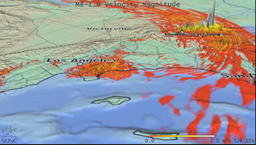M8
From SCECpedia
Jump to navigationJump to searchSCEC M8 Simulation
The SCEC M8 Simulation involved a very large dynamic rupture, run on NSF TeraGrid NICS Kraken in March, 2010, and a very large earthquake wave propagation simulation, run on DOE INCITE NCCS Jaguar in April 2010. M8 can be described as the largest earthquake wave propagation simulation ever performed for the following reasons:
- The M8 computational scale has a combined outer/inner scale of 10 ^ 4.3 (810km/40m)
- The April 2010 M8 science run, using SCEC's AWP-ODC software, achieved sustained performance on a real science problem for 24 hours in excess of 220Tflop/s. When this M8 simulation, no other seismic wave propagation software had achieved more than 100Tflop/s.
- The M8 wave propagation simulation, run on NCCS Jaguar, ran on 223k cores. No other seismic wave propagation application has been used on real science runs using more cores than M8.
- The M8 simulation software, SCEC's AWP-ODC, scaled nearly perfectly up to 223k cores.
- The M8 input velocity mesh required 435 billion grid points more than any wave propagation simulation at the time M8 was run.
The M8 Project is led by Yifeng Cui, Kim Olsen, and Thomas H. Jordan.
SCEC and CME-related Web Sites
- Public CME Website
- Collaborative SCEC Wiki
- SCEC Home Page
- CSEP
- SDSC High Performance Geocomputing Laboratory
- PetaSHA3 Project
- CME Movies and Animations
- CVM-Toolkit
- SCEC Websims Data Management Site
- SCEC CSEP Testing Center
SCEC Computer Science Collaborative Organizations and Resource Providers
- SDSC
- SDSC HPGeoC
- SDSC Visualization Services
- Scientific Workflows at USC/ISI
- Fault Tolerant Computing at CSM
- USC HPCC
- PSC
- NICS
- NCCS
- TACC
- NCSA
- Blue Waters
- Open Science Grid
CME-related 2010 SCEC Annual Meeting Posters:
